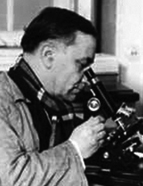

Now, AS tends to believe that determinism is a reasonable horizon, and he leaves signs of this by illuminating history with the light of Kretschmer’s biotypology (thus indirectly circumventing Tyndall’s irreducibility). The predominance of a scientific mentality, reconciling the real and the ideal, corresponded to the cyclothymic type, while the schizothymic type tended to impose the ideal on the real, tending towards absolute, metaphysical and ethically categorical theories. In the case of the European crisis, he would say in O Diabo (1936) that “the fascist-democratic conflict that defines the social moment is clearly a schizothymic-cyclothymic conflict” and that “what happens is that social accentuation is sometimes cyclothymic and sometimes schizothymic: in other words, in the flow of time, the schizothymic and cyclothymic masses are in constant action and reaction. But this action and reaction takes place within a complex that evolves according to a biological curve – the curve of all civilisations – whereby, at the moments of ascent, peak and decline of these curves, this action-reaction will inevitably experience crises and spasmodic schizothymic movements. It is clear that in the current crisis in Europe (...) the Great War caused a great schizothymic oscillation from which fascism, Nazism and communism emerged” (Salazar, in O pensamento de Abel Salazar 1971, pp. 90-92), three ideologies characterised by the predominance of Mysticism.
In his 1942 book, The Crisis of Europe, in which little importance is given to biotypology, AS quotes an author who favoured his organicist belief in the laws of evolution of civilisational systems. The psychiatrist, philosopher and educator, professor at the University of Leipzig, Hermann Schneider (1874-1953), in his works on the cultural achievements of humanity (1912- 1931), stated that these achievements were the result not of racial purity but of miscegenation; as an adherent of a “universal history” that allows for the conception of a philosophy of history, it was his conviction that humanity stores the artistic and intellectual products of the experience assimilated by its best children; given the inaccessibility of the soul of these creators to observation, the historian is obliged to rediscover the spirit of their culture through the monuments they have left behind. Such progress is not linear; it has setbacks and pauses. If this is within the historical sense, his speculative bent leads him to believe that the philosopher of history, scrutinising space and time, can find a pattern to this evolution. In fact, Schneider proposed a three-stage model of civilisational evolution: in the first stage, various human groups which, due t l, geographical and other constraints, remained ethnically pure, meet and mix, followed by phases, the duration of which he indicates in centuries, designated as ‘childhood’, “youth” (during which a new system of ideas is developed through a process of differentiation), “maturity” (in which cultural progress due to the expansion of the new system of ideas is accompanied by critical reflection and in which a popular culture adapted to the needs and capacities of the masses is generated) and “old age” (with the decline of creativity); a new civilisation may emerge, building on what was acquired by the previous one, provided that there is a new racial mixture. The general theory was presented in the work Philosophie der Geschichte (1923), which was translated into Spanish by Labor, cited in A Crise da Europa. The systematic application of the model to various past superior civilisations (Greece, Rome, India, Persia, China) led the reviewer in the British journal History (1933) to criticise the author for his inappropriate generalisation, placing him among the prophets rather than among the “critical historians”. For his part, but in the same general vein, Abel Salazar speaks of “curves of historical systems” marked from “points defined by objective coordinates” which are associated with “quantifiable elements, albeit in a crude form”, noting that a well-known law of history is used for their initial tracing; Schneider is explicitly quoted for the statement of the law: “any new culture arises from a mixture of blood (...)”; Salazar continues by quoting the German philosopher when he states the law regarding the duration of each of the phases of the said curve (A Crise da Europa, pp.
This work is financed by national funds through FCT - Foundation for Science and Technology, I.P, in the scope of the projects UIDB/04311/2020 and UIDP/04311/2020.
